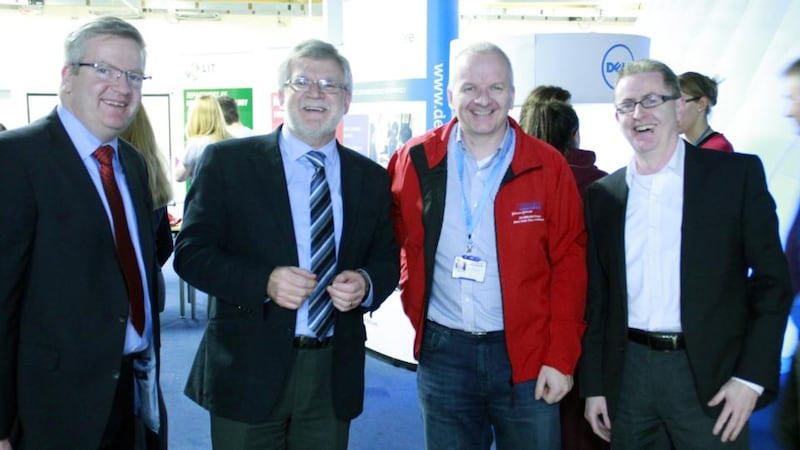The University of Limerick (UL) has been collaborating with industry, other education providers, and local authorities to help provide the skills required for future economic and employment growth in the region.
One such initiative saw the establishment of the UL Enterprise Corridor which encapsulates a convergence of enterprise activity from the Kemmy Business School to the Computer Science & Information Systems Department and the Nexus Innovation Centre. The Enterprise Corridor is now home to the Johnson & Johnson Development Centre which has created 100 high-value jobs.
"The J&J Ireland Development Centre (IDC) is a unique hub of talent based within the UL Enterprise Corridor," says UL research vice-president Dr Mary Shire.

“Software, health and pharmaceuticals are among our strengths and the IDC harnesses that wealth of expertise through links with Lero - our software research institute. The IDC is a world-class operation and a vibrant part of our innovation community on campus.”
Collaboration
“Limerick for IT” is another highly successful collaboration. Established in January 2014, it involves major industry in the Limerick region, including
General Motors
(GM), Johnson & Johnson and
Kerry Group
, joining the University of Limerick, the
Limerick Institute of Technology
, Limerick City & County Council and
IDA Ireland
, in a unique IT skills partnership. Its primary focus was to lead an employer-led skills specific project that would assess future skills needs in order for multinationals to secure further operational mandates and activities, thereby creating a virtuous circle of emerging skills and jobs.
"The main objective was to build a pipeline of job-ready IT graduates to meet global and national needs," says Dr Ann Ledwith, UL director of continuous and professional education. "Limerick for IT has created 200 jobs since it began and has the potential to create 1,000 jobs in the next three years. As a result of its success we have now established a parallel initiative – Limerick for Engineering."
This activity is nothing new for UL. “Engagement with industry has been in our blood since our inception,” Shire adds. “This has been facilitated by a number of things. A huge proportion of our staff come from industry backgrounds. Collaboration with industry is what’s expected; it’s part of our DNA and our reward systems are designed to reflect this. We are also constantly in touch with companies through our student placement programmes and other engagements. With companies it’s about responsiveness. It doesn’t always mean saying yes, but it does mean giving an answer and being open to different types of relationships where both parties’ objectives can be met.”
The success of the university’s approach is reflected in the number of companies working with it.
“We have a very large number of companies collaborating with us both directly and through the national research centres which we host,” Shire explains.
“We have the Synthesis and Solid State Pharmaceutical Centre, the LERO software centre, the Pharmaceutical Manufacturing Technology Centre, and the Dairy Processing Technology Centre. These aren’t here because we are the largest institution but because of our track record in terms of successful collaborations.”
Coming together of minds
But Limerick for IT is quite a different type of collaboration. “It was a coming together of minds,” she points out. “This sort of initiative doesn’t happen overnight. We were approached by Johnson & Johnson and GM with the idea of putting together something that could demonstrate to international corporations that Ireland was capable of providing the skills that they require. But ... having Limerick Institute of Technology (LIT) on board was very important as was the involvement of Limerick City and County Council. We have also worked with the HEA in relation to the courses we are offering. The local authority provides the space for the companies to expand and grow in the future while the third-level partners deliver the skills.”
The programme has been outstandingly successful according to Ledwith. "We started out using Springboard to upskill people," she says. "LIT put on a SAP programme and we ran a joint programme with GM which allowed for the creation of 30 new jobs, Overall, GM has created 60 or 70 new jobs in the region that wouldn't be here if not for the programme.
“We are now starting to look at forward planning and where we are going to take Limerick for IT in future. Getting more students into IT subjects is a big issue nationally and we are going to see a very big shortfall in skills in future years if we don’t address it.”
The expansion into engineering has also proven successful. “We had a very successful Limerick IT event in Dell a number of months ago. It was a show and tell event for kids and their parents and we worked together with LIT on it. The success of that event prompted us to set up Limerick for Engineering.
“We had an engineering event in Dell and that was even more successful than the IT event. Over 1,200 people came through the doors. When you are trying to engage second level students it doesn’t really work if you just have third level institutions there. But we had the companies as well and they were demonstrating state of the art technologies and that worked very well – the kids loved it.”
That success was followed up by an even more high-profile event. “Limerick for Engineering took their message to the St Patrick’s Day parade in the city,” she says.











